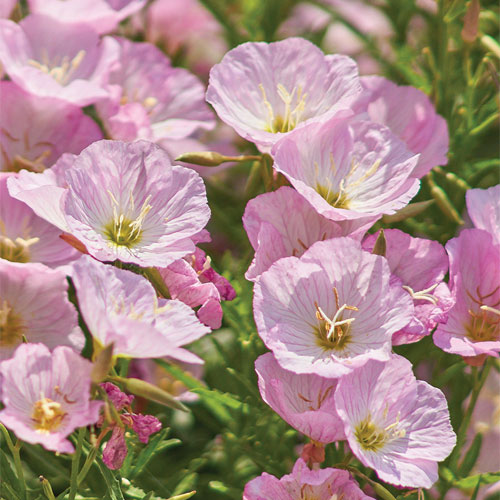Total Number of seeds: 100
Add a touch of soft elegance to your winter garden with Oenothera Speciosa Pink Evening Primrose Flower Seeds 🌸. Known for their soft pink, silky blooms and low-maintenance nature, these winter flowering plants are perfect for both beginner and expert gardeners. Also called Evening Promise, this charming flower thrives in India’s mild winter climates, lighting up your garden beds and pots with stunning clusters of cup-shaped blooms.
Evening Primrose blooms best during the cooler seasons and is loved for its ability to spread naturally and provide long-lasting color. Its delicate fragrance and pollinator-attracting properties make it a valuable addition to eco-conscious gardens. Whether planted in open beds or compact pots, this 30 cm tall flower offers continuous blooming and timeless charm.
Type of Seed: Non-GMO, Open Pollinated
Germination Time: 8–12 days
Hours of Sunlight Needed: Full sun to partial shade (4–6 hrs/day)
Where to Grow: Beds, borders, pots, terrace gardens
Growing Season: Winter
Seed Sowing Depth: 0.5 cm
Ideal Climate: Cool to mild climates
Bloom/Plant Height: Up to 30 cm
Organic Fertilizer Requirements: Use compost every 3–4 weeks
Life Span: Perennial (blooms yearly)
Ideal Growing Temperature: 20–25°C
Blooming/Harvesting Time: 60–70 days after sowing
Maintenance Requirements: Low
Watering Frequency: Twice a week or when soil is dry
Ideal Grow Bag Size: 9–12 inch wide bag or pot


In India, the best time to sow Pink Evening Primrose Seeds is from October to February. The cool winter temperatures support healthy root development and abundant blooming. In regions with mild summer, it may survive longer and continue blooming into early summer.
Choose a medium-sized pot (9–12 inches wide) with good drainage. Fill it with well-draining garden soil and compost. Sow seeds 0.5 cm deep, cover lightly with soil, and place in a sunny area. Water gently after sowing and maintain moist (not soggy) soil.
Preparation: Choose soft, loose soil enriched with compost
Sowing: Sow seeds 0.5 cm deep and space them 20 cm apart
Watering: Water gently after sowing, keep soil slightly moist
Germination: Sprouts appear in 8–12 days
Transplanting: If needed, transplant after 3 weeks into wider pots or beds
Sunlight: Full sun encourages more blooms
Soil: Use sandy or loamy, well-drained soil
Fertilization: Compost once a month helps flowering
Pruning: Deadhead old blooms to encourage new ones
Support & Spacing: No staking required; give 20–30 cm space
Pest Control: Rarely attacked, but use neem oil if needed
Disease Prevention: Avoid overwatering and poor drainage
Mulching: Helps retain moisture in beds
Harvesting: Use fresh blooms for floral decor or let seeds mature
1. Use Nutrient-Rich Fertilizers When Flowering Starts
When your flowers start to bloom, use nutrient-rich fertilizers like Organic Bone Meal Powder or Super Meal Organic Manure. These options help your plants produce bigger and brighter blooms.
2. Choose Organic Fertilizers
Opt for organic fertilizers such as Vermicompost Fertilizer or Cow Dung Manure Fertilizer to naturally boost plant health and improve soil quality.
3. Fertilize at Regular Intervals
Apply fertilizers every 20-25 days using products like Neem Cake to ensure your flowers get a steady supply of nutrients.
Pink Evening Primrose is known for its ability to self-seed and return each season. The delicate pink blooms are lightly fragrant and attract butterflies, bees, and beneficial insects. Its spreading growth habit makes it great for flower beds, cottage-style gardens, and containers.
Grows well in small pots and raised beds
Enhances garden beauty with soft pink flowers
Attracts pollinators naturally
Long blooming cycle with minimal care
Excellent for landscaping and flower arrangements
Avoid soggy or poorly drained soil
Do not overcrowd plants to prevent rot
Protect young plants from heavy frost
Avoid overhead watering to reduce fungus risk
Problem: Yellowing leaves
Solution: Water only when topsoil dries and improve drainage
Problem: Fewer blooms
Solution: Increase sunlight exposure and add compost
Problem: Mold or mildew
Solution: Improve airflow and avoid excess watering
Local Names: Gulabi Sandhya Phool, Pink Primrose, Sandhya Sundari, Shubhra Pushpam, Pink Beli Phool, and Oenothera Flower.
Q: Can Evening Primrose be grown in pots?
Yes, it grows beautifully in pots with 9–12 inch width.
Q: How long does it take to bloom?
It starts blooming within 60–70 days from sowing.
Q: Does it need full sunlight?
Yes, 4–6 hours of direct sunlight is ideal.
Q: Is this a perennial flower?
Yes, Oenothera Speciosa is a perennial and can return each year.
Q: How often should I water?
Water twice weekly or when topsoil is dry to the touch.
Sign in now to receive a 5% instant discount on your first order when using code WELCOME. Begin your organic journey today!
By logging in, you're agreeing to our Terms of Service and Privacy Policy.
Meera
Terrace pot mein sow kiya—germination ~90%, compost‑soil mix se delicate pink blooms aaye aur evening mein terrace chamak uthta hai!
Tanya
Garden border ke edge pe perfect lage—germination ~90%, blooms pink aur consistent evening hours mein khilte hain!
Karan
Germination thoda slow tha (~12 days), flowers delicate the. Compost helpful raha—overall 4★.
Sachin
Flowering phase mein pollinators roz visit karte hain—soil-water-compost combo top‑notch!
Priya
Soil moisture + compost balanced tha—plants healthy rahe aur flowering evening tak consistent rahi!
Ravi
Germination ~87%, watering + sunlight balanced—plants sturdy & evening blooms long‑lasting. Soil drainage acchi thi.
Deepak
Pot mein grow kiya—blooms soft aur fragrant bane. Compost mix essential for petal health!
Arjun
Grow bag mein boya—flowering ekdum evening time pe hoti hai. Pollinators (moths) bhi attract hue!
Neha
Sunlight morning mein aur evening mein blooms open hue—watering balanced, garden serene lag raha hai!
Anjali
Initial stems weak the, compost + watering se recover ho gaya—evening terrace ab romantic lagta hai!